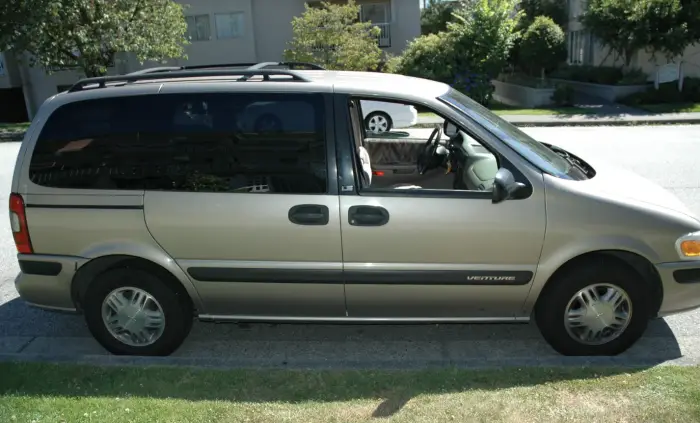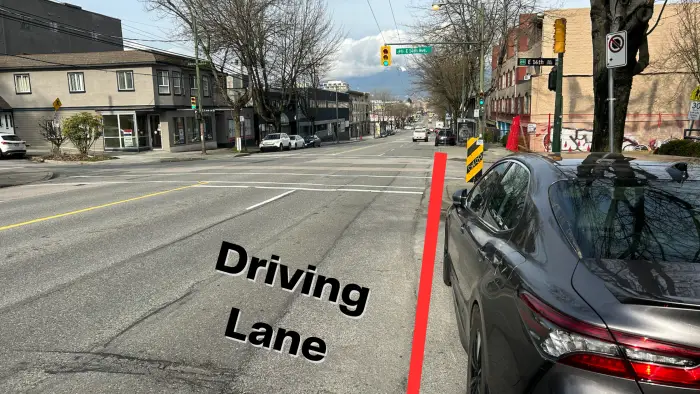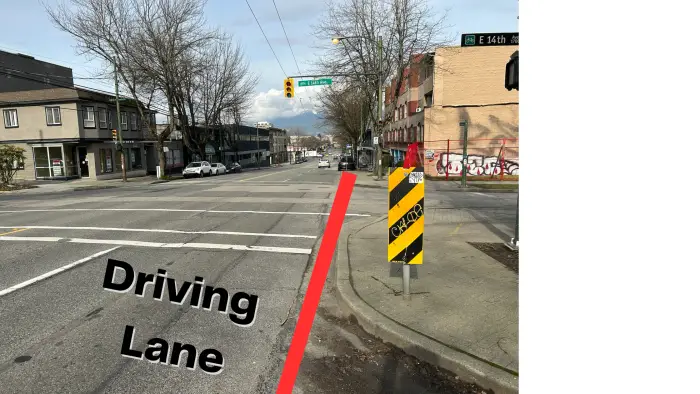Intersections with Bad Visibility – Stop Sign at Commercial Drive & East 14th Avenue
Stop signs are everywhere, and while some of them have good visibility, many of them do not. We still need to deal with them as drivers. In this article, we’ll dive into the process of how to safely turn right, left, or go straight when the visibility isn’t as good as we would like, using Commercial Drive and East 14th Avenue in Vancouver as an example.
For more info about stop signs in general, check out my guide: Stop Sign vs Stop Line Guide for Drivers. This intersection is also controlled by pedestrians via a flashing green light, but we’re just going to ignore that whole thing for now.
I’m curious on whether you have any advice for making right/any turns at intersections with limited visibility. An example is the intersection of E 14th Ave and Commercial Drive (traffic light), facing West (stop sign).
Due to the curve of Commercial Drive on the south side, the down slope, and large parked vehicles right up against the end, it was very difficult to see any cars coming. The visibility on Google Maps is much better than in real life because the camera is mounted as high as a stop sign.
This particular example also has the curb extended out, making creeping out behind the parked car to see better using mirrors difficult without entering the travel lane. Would you have any advice for the best way to handle an intersection like this?
Thank you for the excellent question.
Commercial Drive & East 14th Avenue

Intersections with Limited Visibility
Intersections with limited (or simply bad) visibility are a real thing. I do have some recommendations:
- Deeply understand exactly where your front bumper is (learn about the front blind zone for your particular vehicle)
- Determine exactly which part(s) of the road the traffic is actually using/driving on
- After yielding to any pedestrians of course, don’t be afraid to roll forward so that your front bumper is exactly in line with the outside edge of the parked cars since the traffic driving down the road won’t be using that space anyway (cars driving down the road will be driving beside the parked cars)
- If you still can’t see from that position, roll forward a bit more until you can properly see. We can not take guesses while driving – we need to make good decisions based on the actual visibility and traffic. There is still some space between the parked cars and the cars that are driving. So if you roll forward a little more, you still won’t be in the way. Usually from this position, you can see what you need to see.
Let’s break this down
Know Where Your Front Bumper Is (Front Blind Zone)
So, this was my very stylish minivan at one point. But you can do this little experiment with whatever car or vehicle you actually drive.

Demonstrating the size of the front blind zone
Park your car on the side of the road so that you can just barely see the tires touching the pavement of the parked car in front of you. This is to demonstrate the size of your front blind zone – the area you can’t see when you’re sitting in the driver’s seat.
When the stop line disappears
This is a similar idea when you drive up to the stop sign and can no longer see the stop line. There’s still some space in front of you that you can’t see. This is a crucial thing for any driver to know.

How much space do you think is there?
Ask yourself how much space you think is there, and then compare it to the actual space that you see when you get out and take a look.
GOAL – Get Out And Look
There is nothing quite like getting out and taking a look at how much space is actually there that you can not see while sitting in the driver’s seat.
Get out and take a look, and try to take a mental note of how much space is there. This is imperative to know when rolling forward at a stop sign to get better visibility.
A kind of optical illusion
It’s always going to be a bit of a judgment thing, but you’ll at least have an idea of the amount of space that you can’t see, and therefore the amount of space that you may roll forward into the intersection before you get in the way of the traffic driving down the road.
In a recent study, 100% of people learning how to drive were surprised at just how much space is there. 100% of learners thought their vehicle was “in the way” when in fact, they were still quite far away from the place that they would be “in the way” of traffic.
If you drive a lot, you may notice learner drivers out on the roads practicing. Some of them who are very new sometimes stop their car as soon as they can no longer see the stopping line because they think they are already there (well, it looks like it from their perspective). It looks something like this:

The amount of space I can’t see – front blind zone

So the space between your front bumper, and the other vehicle’s back bumper is your front blind zone; the space you can’t see. Always keep this in mind when driving, especially at intersections with bad visibility.
Determine Where the Traffic is Actually Driving
If you know exactly where the traffic is driving (what part of the road they are using) then it’ll be easier to roll forward up to a point where your visibility is better but you still aren’t in their way.

I know it’s not always going to be easy to tell where the cars are driving, but if you’re stopped at the stop sign you can try to notice as the cars are driving past, how far away they are (how much space do you have to roll forward?). Be careful when checking it out because cars doing lane changes before the intersection and curves in the road can be misleading.

Space between the stopping line and the driving lane
The other thing to notice is how much distance is there between the white stopping line and the point where you can roll up without being in the way (the outside edge of the parked car). I’m talking in general here, but also for each individual intersection as they can all be slightly different in certain ways.


It’s not uncommon for this amount of space to be as large as your entire vehicle, or even bigger, depending on how fat the sidewalk is and some other factors.




Always look at the big picture
Always try to look at the big picture inside your mind when driving, and also think about things from the perspective of other road users. The only reason the white stopping line is that far back is to yield to pedestrians.
No one expects you to be able to see the traffic from way back there. After you yield to pedestrians, it’s the driver’s job to figure out how far they may roll forward in order to improve their visibility and make a good decision.

Conclusion
Safely navigating intersections like this one is mostly about knowing exactly how far you are able to roll forward without being in the way of the traffic. And also understand that if you still can’t see from there, you’ll need to slowly creep it forward a little more until you can make a good decision because we can not just take chances while driving, especially at intersections, where the majority of collisions occur. Does anyone have another intersection you’d like me to discuss? Let me know on this contact form.
Hidden Playground Zone Sign
I would say the school here is pretty obvious, especially during the time of day when there are many children running around and playing. But I had to mention this hidden playground zone sign on the corner of the intersection. I wonder how many drivers notice this? I know I’m taking it from the pedestrian perspective, but still, let’s call it what it is: a road sign hiding behind a tree. Why do we have so many of these around Vancouver?




Related Articles & Resources:
- Should I Pull Into the Intersection for Left Turns?
- Stop Sign vs Stop Line – Stopping Guide
- Intersections in British Columbia [Driver’s Guide]
- Rules of the Road (Intersections) – ICBC Learn to Drive Smart
Carmen Cohoe
Carmen became a driving instructor in beautiful North Vancouver at the age of 22 due to some crazy people who agreed to hire her. After that, there was never a dull moment teaching many different folks from many different places how to drive using automatic and standard vehicles and a minivan.


